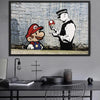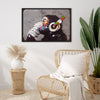
How do you clean a painting?
“How should we clean your paintings?” is a question we are often asked, both on our various social media platforms and by email!
In this article, we'll guide you as much as possible thanks to our fifteen years of experience in wall decoration. So, get a notepad ready; we're going to present some techniques for cleaning your painting in the best possible way.
Clean your painting with a cloth or sponge (both must be new), first dampened with distilled water. Be careful not to apply too much pressure to your painting to avoid any irreversible damage.
As a decorative element, a painting deserves to be showcased. It will therefore need to be maintained from time to time to keep it looking its best and brightest. However, a painting is also a fragile object, and its cleaning must be done with the utmost care. That's the purpose of today's article! You will discover:
- The different types of paintings
- The different methods of cleaning paintings
- Methods of preserving a painting
- Mistakes to avoid when cleaning a painting
We're going to help you clean a painting, the right way and properly. Let's get started, here are our tips!

I) What are the different types of tables that currently exist?
Before learning how to clean a painting , it's important to understand its different types. This will help you better understand how to clean it.
Paintings can be classified into several categories, depending on their support, type of paint and style.
A) The different types of paintings: according to their support
The creation of a painting dates back to antiquity. At that time, painters tended to use chalk on whitewashed tables. Wood thus became an essential support in this field. But over the years, the trend evolved. More and more painters experimented with other materials as supports. And today, there is a multitude of choices. Among the most popular are wood, canvas, and frames.
Wooden paintings are generally made of solid oak. However, other types of wood, ranging from lighter to darker and less robust, can also be used. As for the canvas, it's a support made from linen, cotton, and synthetic fibers . This material is the most commonly used for painting today. Finally, the frame holds paintings on paper. There are several materials available for the frame's edges. You can choose from wood, aluminum, plastic, and so on.
B) The different types of paintings: according to their type of paint
A painting can also be made using several types of paint, the most popular being acrylic and oil paint. Some more modern paintings are also made from printed canvases.
- Acrylic or water-based paint : as the name suggests, it is made from water, pigments, and acrylic resin. This type of paint is very popular with painters because of its quick drying time and excellent coverage.
- Oil paint : This type of paint uses a drying oil binder to coat the pigments. It provides a smoother and more durable finish than water-based paint. In fact, most paintings by great artists are made using this technique, such as Leonardo da Vinci's famous "Mona Lisa".
- Printed canvas : this is a photo that is printed directly onto paper. It will then be placed in a frame to better showcase it.

C) The different types of paintings: according to their style
Finally, there are several styles of paintings. These include: abstract paintings (few shapes and representations) , minimalist paintings (linear and clean lines) , industrial paintings (raw and monochrome motifs) , retro paintings (vintage and old-fashioned style) , Scandinavian paintings (whimsical and feminine motifs)... The choice of painting style will depend primarily on the type of decor you have chosen for your home.
II) What are the different techniques for cleaning a painting?
There are several ways to clean a painting . We've selected a few of them for you:
- Cleaning your painting with a brush : To dust your painting, nothing beats a good brush with soft bristles. This technique is particularly easy to apply. The first thing you'll do is remove the painting from the wall. Then, place the painting on the floor. Tilt it slightly so the dust can fall off easily. Now, use light brush strokes to remove all traces of dust. Proceed gently and delicately to avoid chipping the paint. Clean and dry the bristles of your brush thoroughly before use so that it is more supple and effective.
- Cleaning your painting with your hairdryer : Just like a paintbrush, a hairdryer can also be used as a cleaning tool. This technique is especially effective for dusting paintings. Simply vacuum up the dust using the hairdryer's cool air.
- Cleaning your painting with saliva : it may seem unusual, but saliva is also effective for cleaning paintings. In fact, this technique is already used by most museum restorers. According to studies, saliva has a different texture than water. Being acidic, it doesn't act directly on the paint. By using it, your painting won't risk flaking or being damaged.
To do this, simply soak a cotton swab with a little saliva and dab it on the area to be cleaned.
- Cleaning your whiteboard with a cloth dampened with mineral water : It is also possible to clean your whiteboard with mineral water. To do this, simply dampen your cloth with mineral water and apply it to the area to be cleaned. For better results, use a microfiber cloth, which is more absorbent and drains quickly.
When cleaning, avoid soaking the cloth in water at all costs. Instead, wring it out to prevent excessive reaction with the paint.
- Cleaning your chalkboard with Marseille soap : As you know, Marseille soap has many beneficial and cleaning properties. It's therefore natural to want to use it to clean the chalkboard. But for greater effectiveness, it's best to use liquid Marseille soap. This will make cleaning easier and faster.
Put a little liquid Marseille soap on a microfiber cloth. Then, gently clean your canvas with the cloth, using a square motion. Pay particular attention to the dirtiest areas. Once you have finished the entire surface, quickly wipe it dry with a clean, dry, and preferably absorbent cloth. This will prevent the canvas from becoming damp.

- Cleaning your painting with clay stone : Aside from Marseille soap, baking soda, and vinegar, clay stone is one of the most effective cleaners available. Made of white clay and soap, it helps remove all impurities from any surface. One of its biggest advantages is that it doesn't scratch, so there's no risk of damaging your painting. It can also remove even quite stubborn stains.
To use it, simply apply a small amount of clay stone to a cloth. Then, wipe your painting with the cloth, using a circular motion to ensure it is well absorbed. Let it dry and then wipe it with a clean, dry cloth to finish.
- Cleaning your painting with distilled water : Finally, you can use distilled water to clean your most delicate canvases. Simply soak a cotton swab in distilled water and place it on the area to be cleaned. Make a circular motion until the stain disappears. Then, wipe everything with a clean, dry cloth to remove any remaining traces.
It should be noted that this technique is only effective for removing certain types of dirt. Therefore, it should only be used on a specific area, and not on the entire canvas.
III) How to preserve your painting?
To ensure a longer lifespan for your painting, it's essential to know how to properly care for it. Here are some tips for preventing damage and protecting a painting , regardless of its type or style.
A) Choose the right location for the painting
If you want your painting to last, then you must choose its location carefully. For example, avoid placing it in a spot with strong sunlight. Sunlight can affect the paint's pigments , drying them out and making them less vibrant. With excessive exposure, the paint can even fade or disappear. And if it's an oil painting, it will tend to flake and crumble easily. In short, protect your painting from direct sunlight.
B) Avoid contact with moisture
While some paintings are water-resistant, most are not. Therefore, if possible, never place your painting in a high-humidity environment, such as a bathroom or kitchen. At the very least, frame it if you must display it in such a place.
Also avoid placing your painting near your windows or door. Raindrops could damage it.

C) Limit temperature variations
Temperature is also a crucial factor that should not be overlooked if you want to ensure the preservation of your painting. The temperature in the room where it is displayed should remain constant, ideally between 18° and 22°C. If there are significant fluctuations, the paint could deteriorate more quickly. Also, avoid exposure to drafts, which can gradually damage the paint.
D) Keep the area where the painting is hung clean
It's important that the wall, and even the place where the picture is hung, is clean. So clean it frequently. Remove dust and all kinds of debris.
E) Pack the painting securely when not in use
You may be moving or may no longer wish to hang the painting. To ensure its preservation, wrap it in wrapping paper or place it in an airtight bag. This will protect it from external elements: dust, wind, mold, etc.

IV) What mistakes should be avoided when cleaning a painting?
Many cleaning methods can be found online, but not all are necessarily effective. Here are a few examples... Mistakes to avoid when cleaning a painting:
- Using oil and alcohol : Some people might advise you to use oil or alcohol to clean your paintings. But since these are chemicals, they can quickly damage the paint.
- Using tap water : yes, really! Tap water is not recommended for cleaning a painting, especially if it's made with watercolors. It can erase the paint or change its texture.
- Using food as a cleaning tool : there's a method that involves using bread or a cut potato to clean the painting. But whatever you do, don't! It will only leave residue on the canvas, guaranteeing a disastrous result...
If you are really unsure about the right cleaning product to use or the method to use, don't hesitate to seek help from a professional.
Thanks to this article, painting cleaning techniques will no longer hold any secrets for you. You now know how to clean and care for your painting while respecting all the necessary precautions.
But in addition, you've received some tips on how to better preserve it. Now all that's left is for you to get started and apply the methods shared in this article.
To thank you for making it this far, enjoy a 15% discount on your order today with the promo code: BLOG15 .
See you soon.
The Lofty Trend Team.









































